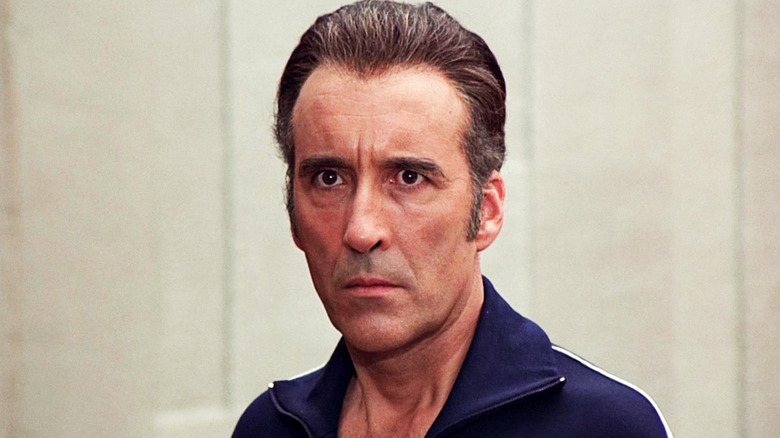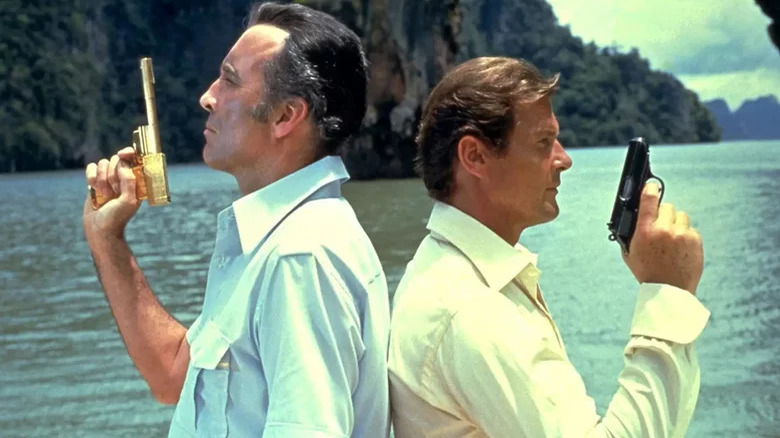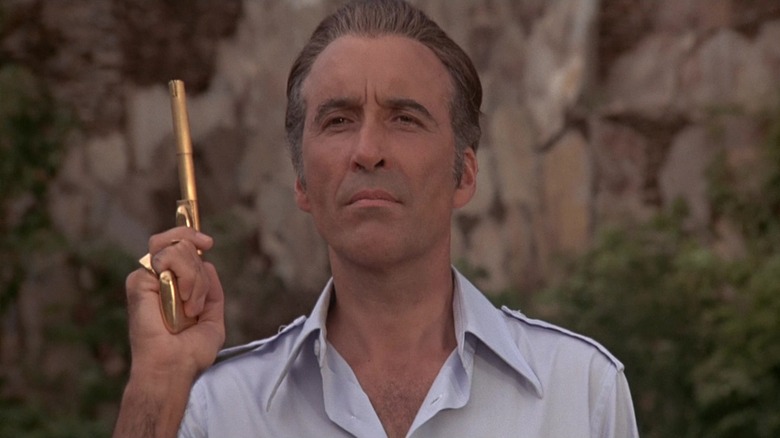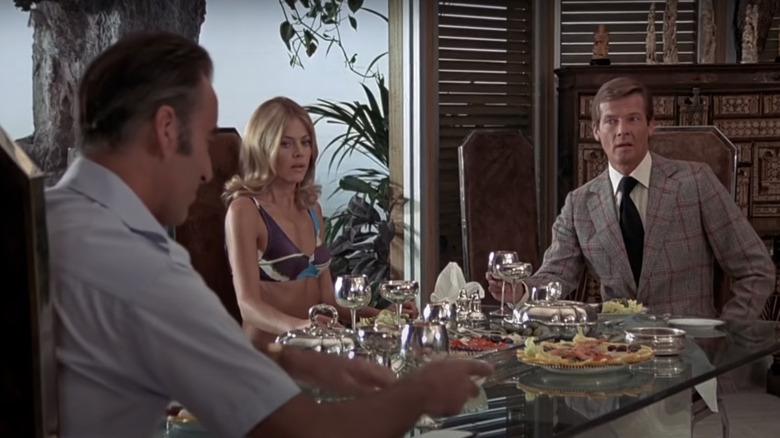The James Bond Series Casting Christopher Lee Proved Controversial Behind The Scenes
Of all the James Bond movies, "The Man with the Golden Gun" isn't the most beloved. Debuting to lackluster reviews in 1974, following the success that was '73's "Live and Let Die," Roger Moore's sophomore outing as Bond failed to dazzle audiences who were growing weary of the franchise.
The producers had a rough time replacing Sean Connery, who'd come to define the character with his run as England's greatest spy, before departing the series and being replaced by Aussie actor George Lazenby. While Lazenby did a solid job in "On Her Majesty's Secret Service," he too left the role after his one and only appearance, after which Connery returned for the less than stellar "Diamonds Are Forever."
Unfortunately, Connery would once again leave the role that helped launch his career following this brief return, clearing the way for Roger Moore to take on the mantle with "Live and Let Die." Due to that movie's success, producers Albert Broccoli and Harry Saltzman rushed "The Man with the Golden Gun" into production and unveiled the film a year after "Live and Let Die." Sadly, Moore had yet to determine how best to separate his Bond from Connery's version, and that combined with a muddled script resulted in an underwhelming response to "Golden Gun," which remains the fourth lowest-grossing film in the Bond series.
But the movie isn't without its charms. Case in point: Christopher Lee, who delivered a memorable turn as the eponymous villain. He may not have been the most outlandish rogue to ever clash with Bond, but Lee's talent for portraying villains was on full display, and he proved a worthy adversary for 007. It's odd, then, that one of the film's biggest strengths proved to be one of the most controversial decisions behind the scenes.
Casting the man in question
The titular "man" in "Golden Gun," was of course Francisco Scaramanga, an assassin-for-hire who charged a cool million dollars per contract. Envisioned by Christopher Lee as a sort of villainous equal to Bond, his Scaramanga exhibited much of 007's urbanity and refined manner, even while he killed for profit rather than for Queen and country. Thanks to the actor's obvious competence and his usage of one of the most recognizable weapons in Bond history, Scaramanga remains one the best Bond villains. Lee's casting should have been a no-brainer, then.
It was anything but.
The film's script was written by Richard Maibaum and Tom Mankiewicz, who had previously penned the "Diamonds Are Forever" screenplay, with Mankiewicz going on to write Roger Moore's debut "Live and Let Die." For its follow-up, Mankiewicz was re-teamed with Maibaum, which should have resulted in more Bond magic — especially since director Guy Hamilton was also on board. The man who'd overseen what is widely considered the best Bond movie in "Goldfinger" was unable to rescue what would be his fourth and final Bond effort, however. And part of the issue here might just reside in the fact that none of these guys were all that happy about Christopher Lee being cast in the first place.
Initially, as Lee revealed in an Empire interview, the producers wanted Jack Palance for the role of Scaramanga, but the veteran star turned it down. Guy Hamilton then met with Lee to offer him the role, and that was that. But it turns out things were a lot more complicated behind the scenes, especially when it came to the writers, who were reluctant to reach out to Lee in the first place.
'I begged and pleaded'
In Edward Gross and Mark A. Altman's book chronicling the history of Bond, "Nobody Does it Better," both Richard Maibaum and Tom Mankiewicz spoke about casting Christopher Lee, and each of them had some kind of hesitation or concern. Mankiewicz seemed to be the most against the decision, saying:
"I actually begged and pleaded and banged the table to have Jack Palance play Scaramanga. I thought he would have been perfect. That was exactly the guy I thought it should have been. I just thought it should be [the Palance-starring 1953 film] 'Shane.' It didn't turn out to be 'Shane.' It should have been Jack Palance and Alan Ladd. It should be the two greatest gunslingers."
For his part, Maibaum seemed similarly disappointed with Lee's casting, saying he didn't think the actor was "properly cast as Scaramanga." Interestingly enough, Maibaum wanted the film to skew more towards Ian Fleming's original novel, with the co-writer adding:
"I thought the character should be what he was in the book, which was a South American assassin who came from a circus background. It would be a very colorful kind of thing. But Christopher Lee got in his head, and they agreed with him, that Scaramanga should be just like James Bond, except that he veered over to crime. There was really no conflict between them from the standpoint of personality. Consequently, the scenes flattened out a bit, I thought."
A little too Bond?
Richard Maibaum's concerns were echoed by two other commentators quoted in "Nobody Does it Better." In particular "The Predator" co-writer Fred Dekkar opined that Christopher Lee was "a really interesting and cool Bond villain" but decried Scaramanga being played as "a little too trying to be Bond himself." That seemed to be a major sticking point for both he and Maibaum, but as pop culture commentator Glen Oliver is quoted as saying in the book, this approach did at least mark a departure from the more fantastical and grandiose villains against which Bond had faced off previously.
Whatever you think of "Golden Gun," Lee is hardly the worst part of the film, which remains an underrated Bond movie deserving of more respect. As a seasoned "Goldeneye 64" player, I'm very familiar with the iconography of the Golden Gun itself and its importance in Bond history. For introducing such a legendary firearm alone, "Golden Gun" deserves more respect. But beyond that, Lee's approach to Scaramanga as Bond's equal is actually a pretty intriguing take that could have made for a much more interesting narrative.
Contrary to Maibaum's contention that this portrayal resulted in there being "no conflict" between Bond and Scaramanga, I think the conversation between Roger Moore's 007 and Lee's villain over dinner, prior to their ultimate duel, demonstrates that not only was there an entertaining tension that arose from their clash of wit, there was a lot left to explore in the characters' similarity. As Scaramanga puts it, "You work for peanuts, a hearty well done from Her Majesty the Queen, and a pittance of a pension. Apart from that we are the same." Had Maibaum unpacked that idea a little more, perhaps he would have been more impressed by his own movie.



